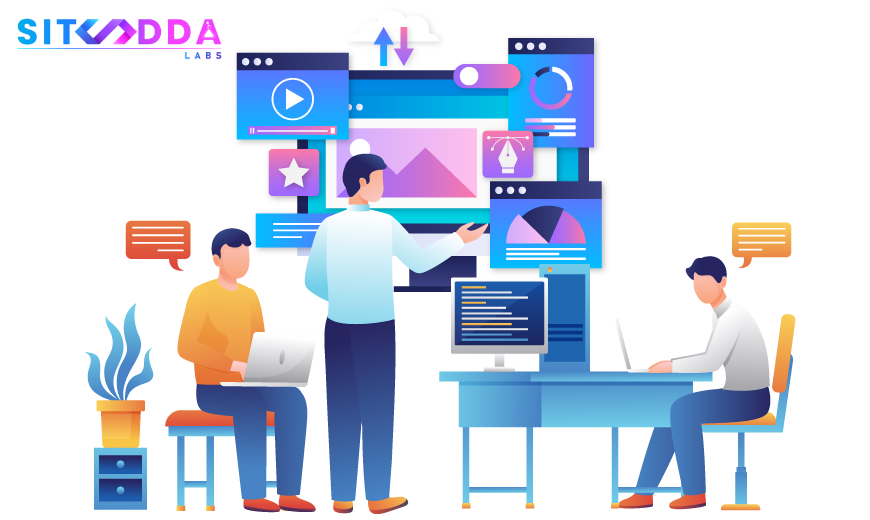Web Design and Web Development
Web Design
Web design encompasses all aspects of a website’s usability and visual appeal. It includes all facets of UI/UX (user interface and user experience), including color scheme, layout, and information flow. Key resources and abilities that distinguish web designers include:
Adobe Creative Cloud : Programs like Photoshop and Illustrator assist designers in producing logos and other visual components for websites.
Graphic design : In order to make a website aesthetically pleasing and improve the user experience overall, graphic designers create layouts and images.
UI/UX design : The goal of UI/UX design is to prioritize usability and navigation in order to create intuitive user interfaces and seamless user experiences.
Figma : This browser-based design tool facilitates high-fidelity mock-up creation, collaborative design work, and prototyping.
Wireframes and mock-ups : Before any coding starts, wireframes and mock-ups assist designers in organizing layouts and a website’s visual structure.
Typography and color palettes : A website’s visual identity can be shaped and its design can be in line with branding objectives by carefully selecting fonts and color schemes.
What people see on their computer screens or mobile devices is the main emphasis of web design. They use layout, typography, and imagery to make the digital experience come to life. Designers are adjusting to emerging trends, such as voice UI design, which requires interfaces to take spoken interactions into consideration.
Many web designers are familiar with HTML, CSS, and JavaScript in order to construct living mock-ups. They frequently utilize WordPress and other template services to create web pages with plug-ins and themes.
Designers can now develop flexible layouts that fluidly adjust to various screen sizes and devices thanks to modern responsive design approaches like CSS Grid. In the sector, dark mode design is also becoming more significant since it affects color schemes and visual aesthetics.

Emerging trends in web design
Web design trends are always evolving to satisfy consumer demands and expectations as technology progresses. The following are some of the major trends influencing the field:
Voice UI design : In order for web sites to respond to spoken commands and offer a smooth voice user experience, designers are adjusting to voice interfaces.
Responsive animations : Animations that dynamically adapt to various screen sizes are being used by designers to improve the visual flow for consumers on tablets, smartphones, and PCs.
Dark mode design : Dark mode is becoming more and more common in web design, influencing color schemes and aesthetics to make viewing more pleasant, particularly in dimly lit areas.
Augmented reality (AR) and virtual reality (VR) : Through the use of web browsers, these technologies give users engaging, interactive experiences.

Web development
Web development is the engineering that supports a website and ensures that everything runs without a hitch. It is usually separated into two primary sections: the client-side (front-end) and the server-side (back-end).
Front-end developers concentrate on the website’s user interface. To make online designs come to life, they utilize HTML, CSS, and JavaScript. Among the essential tools and technologies are:
CSS preprocessors for effective style management, such as Sass or LESS.
The way that developers create dynamic and responsive online apps has been completely transformed by JavaScript frameworks like AngularJS, React, Ember.js, and Vue.js.
Libraries like jQuery. Git and GitHub for version control.
To ensure that the website appears highly in search engine results, they also employ on-site search engine optimization, or SEO. While designers contribute the visual assets, front-end developers are responsible for integrating these elements into the web pages.
Web applications’ data and server-side operations are managed by back-end developers. Key resources and abilities consist of:
- PHP, Python, Java, and C# are examples of programming languages.
- Frameworks that make it easier to create reliable server-side applications include Ruby on Rails, Symfony, and.NET.
- database administration systems, such as PostgreSQL, MongoDB, and MySQL.
- Technologies for security and authentication, such OAuth and Passport, are used to safeguard user privacy and data integrity.
- Full-stack developers are web developers who are skilled in both front-end and back-end programming. They are very adaptable in the IT sector because they can manage every facet of web design and web development, from intricate server administration to user interface design.

